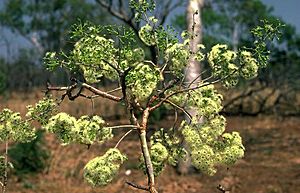Broad-leaved carbeen facts for kids
Quick facts for kids Broad-leaved carbeen |
|
|---|---|
 |
|
| Scientific classification | |
| Genus: |
Corymbia
|
| Species: |
confertiflora
|
| Synonyms | |
|
|
The Corymbia confertiflora, often called the broad-leaved carbeen or the rough leaf cabbage gum, is a type of tree. It grows only in northern Australia. This tree has rough, patterned bark near its base. Higher up, the bark is smooth and pale grey. It has a mix of young and adult leaves. You can see many flower buds growing in groups of seven on parts of the branches that don't have leaves. Its flowers are creamy white, and its fruit looks like a cylinder, barrel, or bell.
What Does the Broad-leaved Carbeen Look Like?
The Broad-leaved Carbeen is often a bit crooked or straggly. It usually grows to be about 3 to 18 meters tall. It has a special woody swelling at its base called a lignotuber. This helps the tree regrow if it gets damaged.
Its bark is dark grey and rough near the bottom. Then, it suddenly changes to smooth, white, or pale grey bark higher up. This smooth bark peels off in thin flakes. The tree often loses its leaves during the dry season.
Young plants and new shoots have round or heart-shaped leaves. These leaves are 98 to 230 mm long and 42 to 170 mm wide. They grow in opposite pairs and don't have stalks. The leaves on the main part of the tree are a dull green on both sides. They can be heart-shaped or egg-shaped. These leaves are 60 to 160 mm long and 25 to 103 mm wide. They either have very short stalks or no stalks at all.
The tree's flower buds grow on parts of the branches without leaves. They are found on a branched stalk up to 20 mm long. The buds grow in groups of seven or more on each part of this stalk. Each bud has its own small stalk, 7 to 30 mm long. When mature, the buds look like pears. They are 4 to 7 mm long and 4 to 5 mm wide. They have a rounded cap, sometimes with a point.
The Broad-leaved Carbeen flowers from July to December. Its flowers are a lovely creamy white color. The fruit is a woody capsule. It's shaped like a cylinder, barrel, or bell. The fruit is 7 to 16 mm long and 6 to 12 mm wide. Its walls are thin, and the parts that open are hidden inside the fruit.
How Did This Tree Get Its Name?
The Broad-leaved Carbeen was first described in 1859 by a scientist named Ferdinand von Mueller. He first called it Eucalyptus floribunda. However, that name was already being used for another plant. So, when Richard Kippist wrote down Mueller's description, he changed the name to Eucalyptus confertiflora. Because of the rules for naming plants, Kippist is given credit for the name, even though Mueller provided the description.
Later, in 1995, two scientists, Kenneth Hill and Lawrence Alexander Sidney Johnson, changed the name again. They moved the tree to a different group, calling it Corymbia confertiflora.
The second part of its scientific name, confertiflora, comes from Latin words. Confertus means "crowded," and -florus means "-flowered." This refers to how the flowers grow in crowded groups.
Where Does the Broad-leaved Carbeen Grow?
The Corymbia confertiflora tree is found all over northern Australia. You can see it in the Kimberley area of Western Australia. It also grows across the Top End of the Northern Territory and in south-eastern Arnhem Land. You can find it near the coast around the Gulf of Carpentaria and as far as Townsville and the Kennedy River in Queensland.
This tree likes to grow in open woodlands and forests. It's often found on flat lands and along riverbanks (called levees). It also likes areas where there is limestone.


